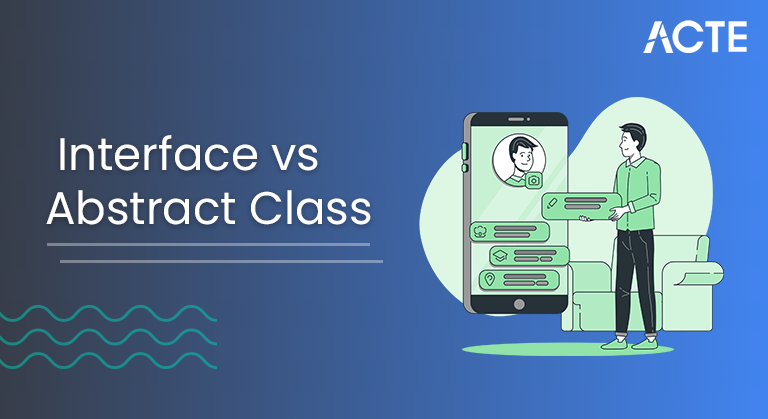
The key technical differences between an abstract class and an interface are: Abstract classes can have constants, members, method stubs (methods without a body) and defined methods, whereas interfaces can only have constants and methods stubs.
- Introduction:
- Tools
- Breaking Opportunities and Impact
- Features / Characteristics
- Types/methods
- Synatx
- How it works
- Why it is needed and important?
- Trends
- Benefits
- Conclusion
Introduction:
Interface
The interface can refer to any of the following:
1. When talking about software, the interface may be a program that permits the user to speak directly with computers or the network. The connection can also ask the controls utilized in the system that allows the user to interact with the system. one among the simplest samples of a visible interface is that the GUI (Graphical interface ). this sort of interface is what you employ now to navigate your computer and the way to urge to the present page.
2. When it involves hardware, the interface may be a portable device, port, or computer-connected device, or other hardware. for instance, IDE and SATA are hard disc drive connectors and ATAPI may be a pre-existing connector for CD-ROM drivers.
3. An abstract Class may be a descriptive explanation of the procedures and variables of a category (item Class) containing one or more well-thought-out plans. All object-oriented programming languages (OOP) interface classes, covering Java (see Java abstract section), C ++, C #, and VB.NET. Items or classes could also be denied, which suggests they’re refined into components that conform to the prevailing system’s performance.
4. Individual situations from classes are things. Declaring a category as an Interface object means it can’t be directly verified, which suggests it can’t be wont to create an object. This prevents the code from being tampered with. Subclasses of interface classes are required to further define the attributes required for every take. Concrete classes are a hard and fast type, whereas interface classes aren’t. There are not any abstract methods during a concrete class, and that they are often reinforced and coded.
5. Interface classes aren’t required for programs but the concept is provided to stay the code cleaner than it might otherwise and to form editing more efficient because external information isn’t always mentioned. To be platform-agnostic, Java code is compiled into classified files which will be translated into any Java VM. Once the compatible Java VM has been downloaded and installed on the OS, the resulting class file are often used on multiple machines.
Interface Tools
Interface classes are sorts of planning structures that allow engineers to define a good range of behaviors that will be applied to highly specific constructions. In an object-oriented program, Abstract classes are wont to support polymorphism and inheritance between superclass and subclass objects.
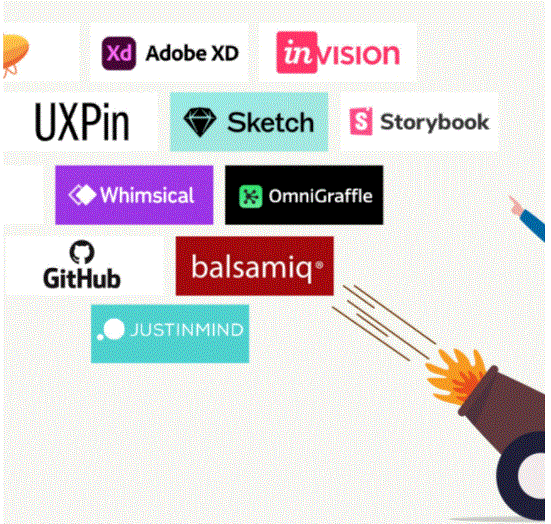
Table of contents display
Depending on the language, Interface categories are often termed conventions, links, or several other words wont to classify objects. Interface classes, which may be fully or partially abstract, provide developers with a good range of flexibility and options for supporting object-oriented design principles.
- Interface class features
- Abstract Class must be declared with an Interface keyword.
- There are often subtle and subtle ways.
- It can’t be verified.
- It can have builders and vertical paths also.
- It may contain substrates that will force the subclass to vary the body of the trail.
Features / Characteristics:
Interface features:
The interface may be a template that only contains method signatures. the trail signature contains the parameter numbers, the parameter type (value, reference, or output), and therefore the order parameters. The interface can’t be started by itself because it contains only the outline of the trail s with no path of the path. The visual connector is defined using the visual interface keyword. Additionally, you can’t install the interface. the varied features of the interface are as follows:
The interface is employed to encrypt multiple assets with code. This interactive feature is extremely different from that of the non-visible categories because the category cannot detect quite one class feature but can easily use multiple connections.
It describes a selected set of methods and their arguments.
Types/methods:
Interface types:
Command Line Interface
The command-line interface is not any longer as common in everyday consumer products as basic user interaction, but it’s still used under certain conditions. The Command-Line Interface requires users to type the required commands into the instruction. the pc is told to travel to the specified file or directory first. From there, a plethora of commands is out there, starting from file retrieval to application execution.
Operated Menu interface
The user-driven menu gives you a spread of commands or options within the sort of an inventory or menu that’s displayed full screen, pop-up, drop-down, or drop-down. ATM is an example of a virtual menu operator.
Graphical User Interface
The graphical interface, or GUI, is that the sort of visual interface most people are most conversant in. You interact with these links employing a mouse, trackpad, or other peripheral to spot and click on images or thumbnails.
User Visual Touch Screen
Touch screen user interfaces (GUIs) are common on tablets, smartphones, and medical devices like the t: slim insulin pump. The touch screen GUI has equivalent benefits and disadvantages as normal GUIs, but it also delivers a way more up-close approach to communication. Touch screen GUIs are made much easier by peripheral inadequacies. Of the four sorts of visual effects, the graphic interface is that the commonest, followed by variations of the touch screen. apart from other technologies that exist already and still emerge, the GUI remains the well-liked standard. this is often largely thanks to its simplicity and simple use.
Abstract type:
In programming languages, the abstract type may be a systematic sort of system which will be directly verified; the non-abrasive type – non-reinforced – is named concrete type. All samples of the Interface type are typical of a specific concrete subtype. Interface species also are referred to as extinct species.
The abstract type may provide an initiation or an incomplete implementation. In some languages, abstract forms that aren’t used (rather than incomplete) are referred to as contracts, links, signatures, or class types.. within the general system, an equivalent concept is that the same concept, an equivalent that defines syntax and semantics, but doesn’t require a subtype: two unrelated forms may satisfy an equivalent concept.
Typically, intangible types will have one or more uses provided separately, for instance, within the sort of sub-concrete types which will be reinforced. In an object-focused system, the intangible Class may include intangible pathways or intangible features [2] assigned to its sub-categories. Other names for language features (or which will be wont to use obscure genres include features, mixes, tastes, roles, or genre classes.
- interface {
- // announce permanent fields
- // announce vague methods
- // by mistake.
- }
- virtual connector print {
- blank print ();
- }
- Printed A6 Class Resources {
- public void print () {System.out.println (“Hello”);}
- public static void main (String args [])
- {
- A6 obj = new A6 ();
- obj.print ();
- }
- }
- Abstract Class:
- The class that is declared Interface is known as the Interface class. There can be subtle and subtle ways. It needs to be expanded and its method used. It cannot be verified.
- abstract class A {}
- The method declared as vague and unused is known as the Interface method.
- abstract void printStatus (); // with body path and invisibility
- In this example, Bicycle is an Interface classroom that contains only the Interface path used. Its launch is provided by the Honda classic.
- Anonymous class bike {
- abstract void run ();
- }
- Honda4 class expands bike {
- void run () {System.out.println (“runs safely”);}
- public static void main (String args []) {
- Bike obj = new Honda V4 ();
- obj.run ();
- }
- }
Syntax:
Interface:
The interface is advertised using the interface of the interface. Provides complete discharge; it means all paths within the interface are declined with an empty body, and everyone’s fields are public, stationary, and auto-complete. The communication class should use all the means laid out in the interface.
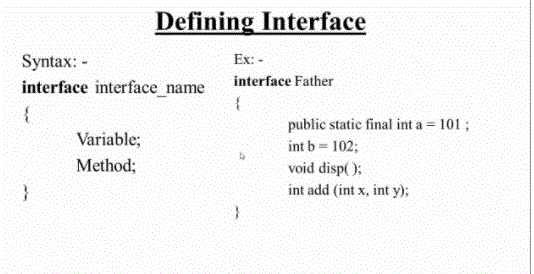
How its works:
Abstract Class:
Abstract classes are like workshops. you’re unable to authenticate them, and that they may contain a mixture of methods announced with or without implementation. However, with Interface classes, you’ll declare fixed and unchanging fields, and define public, protected, and personal concrete methods. Abstract Class: maybe a limited Class which will be wont to create things (to achieve that, you want to achieve another Class). Abstract method: can only be utilized in the Interface class, and it’s nobody. The body is provided by a subclass (inherited).
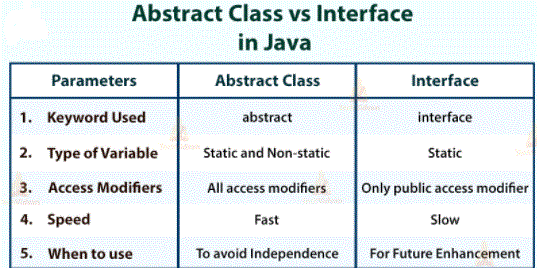
Why it is important?
Why can we use the interface? it’s wont to achieve an entire release. Since java doesn’t support multiple assets during a classroom environment, but by employing a visual interface it can gain tons of legacy. the rationale is, Interface categories can contain non-final variables, while the variables within the visual interface are final, public, and static.
Why do we use abstract classes?
Interface class allows you to make a functionality that will be employed by subclasses or exit. The visual interface only allows you to define functionality, not use it. And while the category may expand on just one subtle Class, it can take the chance to collaborate more.
Trends:
Interface
The modern UI fits the prevailing view of your audience of what they think is acceptable as a reliable visual experience. Components of the UI design include user-focused viewing trends, design usability, patterns, and flow-through structures that are appropriate as a part of a contemporary UI.
Abstract Class:
An abstract class may be a descriptive description of methods and variables of a category (Class of objects) that contains one or more thought-out methods. Interface classes are utilized in all object-oriented programming languages (OOP), including Java (see Java abstract section), C ++, C #, and VB.NET. Items or classes could also be excluded, meaning they’re summarised into features that correspond to the performance of the present system.
Individual situations from classes are things. Declaring a category as an Interface object means it can’t be directly verified, which suggests that an object can’t be created from it. That protects the code from being misused. Interface classes require subclasses to further define the attributes needed for every take. Interface classes are against concrete classes, which are a hard and fast type. The concrete class has no abstract methods and may be reinforced and coded.
Interface classes aren’t required for programs but the concept is provided to stay the code cleaner than it might otherwise and to form editing more efficient because external information isn’t always mentioned. To be platform-agnostic, Java code is compiled into classified files which will be translated into any Java VM. The resulting class file can work on different machines once the compatible Java VM has been downloaded and installed on the OS.
- Abstract class in Java is very useful for writing short codes.
- Withdrawal from Java avoids code duplication.
- Abstract classes enable code reuse.
- Changes to internal code usage are made without affecting classes.
Benefits:
Interface
Interfaces are very powerful. Used properly, optical connectors offer all the benefits listed below.
1. The interface allows us to use polymorphic behaviour. Of course, abstract classes can also be used to apply polymorphic behaviour.
2. Visual connectors allow us to develop loose-coupled systems.
3. Interaction allows mockery to test a better unit.
4. Collaboration enables us to use multi-stage asset in C #.
5. Visual connectors are excellent for using Inversion of Control or Dependency Injection.
6. Visual connectors enable the development of a compatible application.
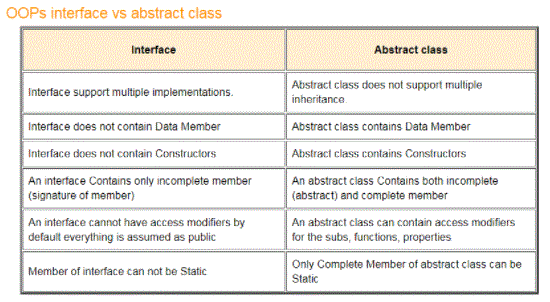
Abstract Class:
Conclusion
Interface
Using the interface, you’ll define a little package of skills and use the virtual interface within the classroom. The interface doesn’t provide code beyond the name of the path; the startup section should provide the code selected for the interface. … for instance, in some cases, the interface and client code may have to be changed.
Abstract Class:
Using Abstract classes is a crucial part of coding top-quality content. Interface classes function as a blueprint for explaining the way to implement a specific project. this easy architecture goes an extended way in ensuring that you simply write flexible code which will withstand the ever-changing future requirements of the system. Usually, once you study in school you’ll get to find the source of a specific method. By understanding common classroom structures within applications you’ll make your research and understanding of the new system much faster.





